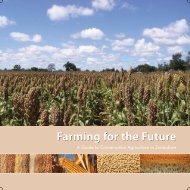Restoring the Soil - Canadian Foodgrains Bank
Restoring the Soil - Canadian Foodgrains Bank
Restoring the Soil - Canadian Foodgrains Bank
Create successful ePaper yourself
Turn your PDF publications into a flip-book with our unique Google optimized e-Paper software.
Annex 2: The Evidence83this level of increase is quite common when we use gm/ccs.The one case I have followed most closely is <strong>the</strong> maize/mucuna system in nor<strong>the</strong>rnHonduras (S1). It is a very interesting case, and quite well documented (see, forinstance, Bernard Trombley’s Cornell University doctoral dissertation). In this case,thousands of farmers working on poor tropical soils with a parent material low inphosphorus have been planting maize and mucuna on <strong>the</strong> same fields every year for40 to 45 years. Most of <strong>the</strong>se farmers have never applied chemical phosphorus to <strong>the</strong>soil. Yet, after 40 or more years of harvesting maize at rates of 1.5 to 2.5 t/ha, <strong>the</strong>ystill are having no problem with phosphorus availability in <strong>the</strong> soils. In fact, Bernardfound no yield response to adding phosphorus to <strong>the</strong>se soils.In most of my travels across more than 45 developing countries, I have observedgm/cc systems in use. Yields have doubled or tripled in case after case. Yet I havenever observed a serious phosphorus deficiency, even where farmers have applied nophosphorus for decades. The nor<strong>the</strong>rn Honduras phenomenon is not an exception. Itis well within <strong>the</strong> normal range of cases.So what is happening? How can farmers take significant levels of phosphorus everyyear out of a soil that was never particularly rich in it anyway, and do so without runningout of phosphorus?One answer, of course, is that <strong>the</strong> incredible amounts of organic matter added to <strong>the</strong>soil have increased <strong>the</strong> available phosphorus by 100%, or maybe even several hundredpercent. That would explain a good part of <strong>the</strong> mystery, but not all of it.I think <strong>the</strong> problem may well lie with one inherent assumption that undergirdseverything that has been written above: <strong>the</strong> assumption that <strong>the</strong>se farmers’ fields areclosed systems. Most agronomists don’t even realize <strong>the</strong>y are constantly making thisassumption. Up until now in our discussion, we have been assuming that <strong>the</strong> onlyphosphorus that could possibly exist in each farmer’s field is <strong>the</strong> phosphorus that was<strong>the</strong>re 40 years ago, when <strong>the</strong>y began using mucuna.But this assumption is wrong. It is, in fact, very wrong. I once visited a scientificresearch station in <strong>the</strong> Brazilian Amazon near <strong>the</strong> city of Belen. Farmers <strong>the</strong>re werecutting down virgin forest, largely because of <strong>the</strong> weed pressure on all land that hadbeen farmed for more than a few years. Scientists found that birds and bats depositedan average of 10,000 viable weed seeds on each hectare of new farm land per year.How much phosphorus would be deposited in <strong>the</strong> guano along with those seeds? Wedon’t know, but <strong>the</strong> amount would be significant, especially given that a large majorityof bird species are carnivorous and eat insects ra<strong>the</strong>r than seeds. In addition to thosedepositions, phosphorus would be spread from forest to farm and from farm to farmby microorganisms, insects, earthworms, wild animals, domestic animals, etc.This transfer of nutrients does not only happen near <strong>the</strong> edges of virgin forests. Across<strong>the</strong> Sahel, far larger transfers of phosphorus occur over larger areas because of <strong>the</strong>
















